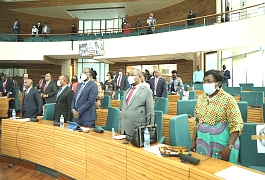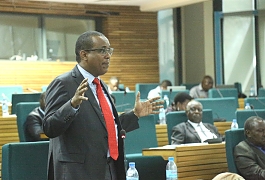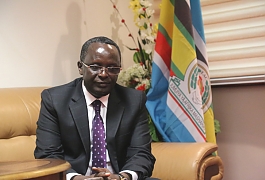Clarifies on the US Dollars 1 million earmarked for the Transport Facilitation Policy and Strategy study
The East African Legislative Assembly (EALA) continued this week with its 2nd Meeting of the 4th Session in the Chambers of the Parliament of Uganda. The Chairperson of the EAC Council of Ministers and Minister in the Office of the President responsible for EAC Affairs of the Republic of Burundi, Hon. Hafsa Mossi responded effectively to all the questions raised by the Hon. Members for oral answers.
Hon. Augustine Lotodo (Kenya), who noted that the East African Integration process was a building block to the bigger vision of a United Africa, wanted to know what linkages had been developed between EAC and the African Union; whether there was a dedicated desk officer at AU Headquarters in Addis Ababa other than the Defence Liaison Officers, and what projects and programmes were being undertaken in collaboration with the AU.
The Chairperson of the EAC Council of Ministers informed the August House that the East African Community, like all other Regional Economic Communities had a symbiotic relationship with the Africa Union. She said a Protocol on Relations between the AU and the RECs was signed in January 2008. It provides a framework for cooperation that would lead to the realization of an African Economic Community as envisaged in the Abuja Treaty (1991). As part of the implementation of this protocol, and following a decision of the AU Assembly to that effect, a comprehensive Minimum Integration Program (MIP) was being developed. The AU Commission had convened sectoral meetings to identify areas for which programs and projects are to be undertaken and benchmarked across the RECs.
Hon. Hafsa Mossi noted that even before the Minimum Integration Program was adopted, the EAC-COMESA-SADC were engaged in a Tripartite Initiative, which was a milestone towards realizing the bigger vision of a united Africa Economic Community. Indeed, the AU Commission was closely following up on the steps the EAC, COMESA and SADC are taking with a view to encourage other RECs to emulate the tripartite initiative.
Other operational linkages were under the Peace and Security sector which already had ongoing programs, guided by the Protocol relating to the Establishment of the Peace and Security Council of the Africa Union. On the basis of this Protocol, a Memorandum of Understanding was signed, which elaborates how and in what areas the RECs and the AU Commission will cooperate in facilitating the full implementation of the Africa Peace and Security Architecture (APSA).
Hon. Hafsa Mossi informed the August House that the program currently being undertaken in partnership with the AU and the EU was the AU Capacity Building for RECS in the Area of Peace and Security. The Project had facilitated the establishment of the Peace and Security Liaison office to AU; supported the Development of the EAC Early Warning Mechanism; supported the Administration and financial Management; and supported the strengthening of Peace and Security Unit at the EAC through four professional staff positions. The Project had also supported the development of the EAC Conflict Prevention, Management and Resolution Framework; and supported the establishment of Linkage with AU and other RECs through installation of videoconferencing facility. The first phase of the project (2007-2010) ended on June 30th 2010 and the second phase had been approved to run through December 31st 2013.
The Chairperson of the EAC Council of Ministers stated that the EAC does not have a Defense Liaison Officer at the AU Commission. This was because the EAC does not host a component of the Africa Standby force. The Partner States were contributors to the SADC Brigade and to the East African Stand-By Brigade which covers Eastern Africa beyond the EAC.
However, within the framework of the Protocol on Peace and Security, the East African Community had, since May 1st 2008 stationed a senior officer, at P5 level, at the AU to enhance cooperation in the Peace and Security areas. The AU is equally exploring prospects of assigning an AU liaison officer to every REC.
The Hon. Minister informed the August House that at their meeting held in January 2010, the Chief Executive Officers of the Regional Economic Communities (EAC, COMESA, and SADC) reviewed the progress on the Abuja Treaty and the related contemporary challenges. They have recommended that the Protocol on relations between the AU and the RECs be revised to align it to the challenges ahead and propel the integration. This will inform the decision on modalities for deployment of RECs’ dedicated officers at the AU Commission.
On the Issue of the US Dollars 1 million earmarked for the Transport Facilitation Policy and Strategy study raised by Hon. Jacqueline Muhongayire (Rwanda), the Chairperson of the EAC Council of Ministers said the money will largely be used on roads transportation issues. The study had already commenced and the consultants were currently visiting Partner States. The Study is aimed at harmonizing the national roads design standards and specifications, road safety codes, overload control regulations and environmental mitigation standards.
This will result in the EAC road infrastructure attaining international standards and ensure similarity of operational outputs, which would make them user friendly to stakeholders. The resources will therefore not be extended to other modes of transport, asserted the Hon. Minister.
Hon. Hafa Mossi reiterated that when the East African Community signed a Grant Agreement with the African Development Bank in February 2007, the bank agreed to fund among others, studies on the preparation of an EAC Transport Strategy and a Regional Road Sector Development Program worth $ 2.2 million and a Transport Facilitation Strategy worth $ 1 million.
The studies form part of the preparatory activities towards the implementation of the East African Trade and Transport Facilitation Project whose main objective was to reduce the cost of doing business in the region and thereby contributing to the economic development and competitiveness of the Community.
The $ 2.2 million assigned to the execution of the EAC Transport Strategy covers all the modes of transport including roads, railways, aviation, maritime, inland waterways and oil pipelines. In addition, it will contain recommendations on the institutional and regulatory reforms needed for its implementation.
ADDITIONAL NOTES TO EDITORS
The objective of the EAC Transport Strategy is to identify regional strategic priorities, interventions and resources for transport sector development and operational needs for the medium term in line with EAC development goals. The development of the Transport Sector Strategy involves consulting services, experts meetings and stakeholder consultations or workshops to assess in detail all modes of transport in their regional dimension. The strategy will be the EAC key planning document guiding the regional policies and investments in the transport sector up to 2018.
The strategy however, contains also a sub-component that will develop a prioritised road sector investment program covering the major transit corridors of the EAC. This was approved by the Partner States on the basis of the ongoing EAC Road Network Project and the need to improve the road transport network, given its relative accessibility and importance in driving intra regional trade.
The EAC Transport Strategy therefore has taken on board the provisions of the Common Market Protocol and as such, the implementation of the Protocol will not be impaired or slowed down by lack of consideration for other modes of transport.
The Community, in addition, is on the verge of legislating on the operations of one stop border posts in the region. The transformation of the region’s two stop border posts currently in operation at most of the border crossings into one stop border posts is a move that will drastically reduce on the time and costs incurred at the border transit facilities in EAC.
It is therefore evident that the Partner States and the Council of Ministers were committed to deliver the necessary infrastructure and logistics facilitation in EAC to underpin the smooth implementation of the Common Market Protocol.



